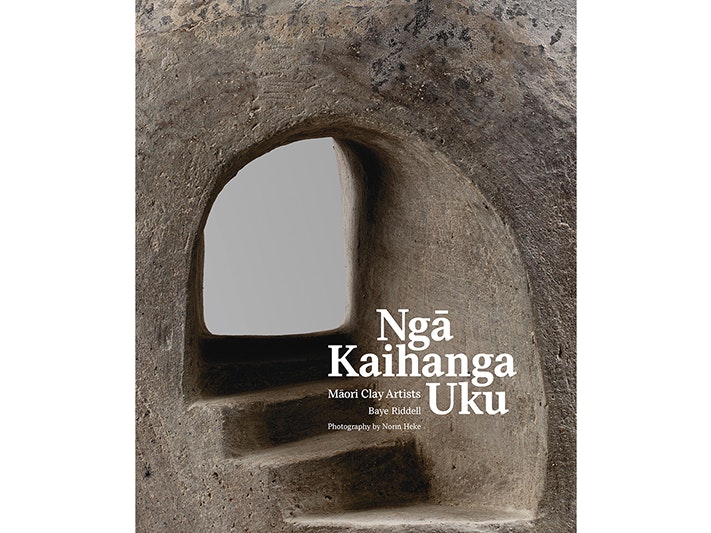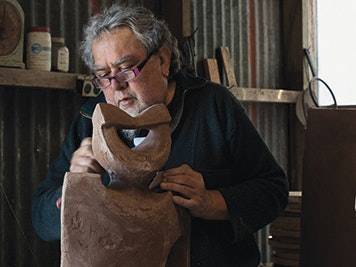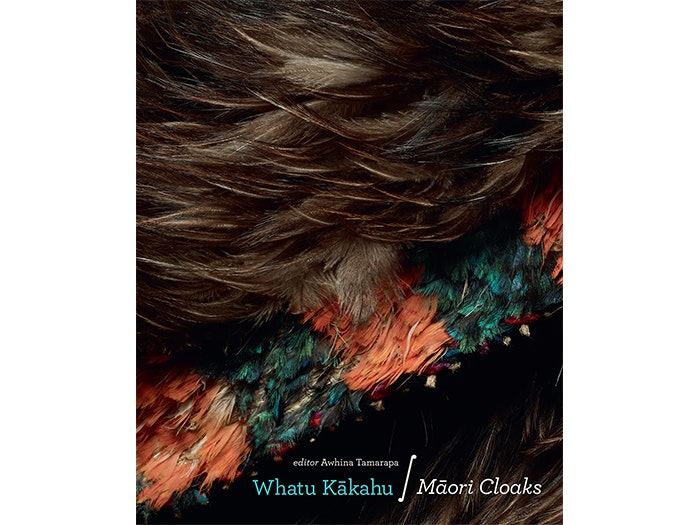
Ngā Kaihanga Uku: Māori Clay Artists
A celebration of the revival and mana of Māori ceramic art.
Free museum entry for New Zealanders and people living in New Zealand
Open every day 10am-6pm
(except Christmas Day)
Free museum entry for New Zealanders and people living in New Zealand
Baye Riddell discusses Ngā Kaihanga Uku: Māori Clay Artists with Te Papa Press.
Baye Pewhairangi Riddell (Ngāti Porou and Te Whānau-a-Ruataupare) became a full-time potter in 1974, the first Māori artist to commit to this profession. In 1986, with Manos Nathan, he was a co-founder of Ngā Kaihanga Uku, the national Māori clayworkers’ collective. In 1989 he and Nathan were awarded a Fulbright Scholarship to establish an exchange with Native American artists. He was awarded the Creative New Zealand Craft/Object Fellowship in 2011.
Baye Riddell. Photo by Norm Heke
Manos and I had discussed the need for an accurate account of the development of Kaihanga Uku . . . a book. We discussed possible writers, but the idea didn’t progress much. When he became ill a sense of urgency to resolve it led to him asking me to write the book. To put his mind at ease I agreed. With the passing of Colleen soon after, the need for this book became more urgent.
I knew it would be a big job but didn’t realise how big, and there were unforeseen challenges along the way. The first task was to define the parameters of the book – what and who to include. There were those who thought it should cover all Māori ceramicists, but I only wanted to cover what I knew and was a part of. To attempt to cover everyone and everything was too daunting for this novice writer!
Any book about people involves a raft of personalities and at times I had to dig deep into the puna of patience to navigate choppy waters. Then the sheer grind of research to make sure everything was correct . . . I couldn’t have done it without the uncompromising help, advice, determination and professionalism of Dr Anna Marie White and the Te Papa Press team in the latter stages, and without the support of Toi Māori.
I believe that the development and articulation of a Māori approach to clay as an artform was achieved relatively quickly because it came through a unified group vision rather than individual artists operating in isolation and trying to promote their own work. As a group, Ngā Kaihanga Uku worked hard to gain a reputation, for reliability, professionalism and authenticity. This enabled us to consistently secure funding when needed for various projects both in Aotearoa and overseas.
We didn’t initially set out to reconnect to ancient Pacific ceramic origins. In fact, I personally was ignorant of that whakapapa. This whakapapa was something we discovered along the way and Colleen in particular was the main initiator of this reconnection – a reconnection we are still growing . . . but yes, there is a sense of destiny in seeing a continuum being re-established.
To Māori the act of creating something is tapu or sacred. The extent to which we elevate the sacredness of that act (for example by karakia, ritual) or reduce it to the mundane (that is, by mass production) determines how ‘profound’ that process and experience is for the maker.
Reciprocal visits and events keep us connected. Also, social media enables us to stay in contact with each other and keep the fires stoked, as it were. Common issues such as cultural retention and resources also deepen the relationships. Support for various kaupapa such as the anagama kiln at Astoria create meaning, enduring friendships and an extended clay whānau.
Yes, each firing is special. The alchemy of the fire produces not only beautiful works but also lasting memories.
These wānanga are important to maintain connections and to share new knowledge and techniques. We also discuss issues and set up new projects.
Definitely. It has been disappointing to see ceramic facilities and equipment being removed from schools and tertiary institutions in the last few years as they are deemed expensive to maintain and gas kilns can pose risks in inexperienced hands. There could be ways to link schools with professionals in the community and/ or pottery clubs.
Yes, it is, but the difficulties of making a living from one’s art is a real hurdle for young artists. Therein lies the real test. Most have a supplementary job or income notwithstanding that the work being produced is excellent, with most having developed a personally identifiable style of their own. Also, key members of the next generation have stepped up to play important roles in Ngā Kaihanga Uku.
Definitely! Within Te Ao Māori, clay work has flourished over the last thirty-plus years mainly through the efforts of Kaihanga Uku building on the foundation of cultural narratives, practices and tikanga. The use of traditional designs and forms wrapped around our stories and worldview make our work identifiably from this land when seen on a world stage. Works by Ngā Kaihanga Uku artists are held in many public and private collections internationally. Within New Zealand, Ngā Kaihanga Uku has won recognition from national galleries and mainstream New Zealand potters’ organisations and publications.
We were fortunate to not have had the gender constraints that most traditional Māori artforms had. We were careful not to be too prescriptive about the appropriate tikanga for clay, allowing each one to explore and define that for themselves. Having said that, there are common tikanga associated with working in any artform as a Maori artist – karakia, design appropriateness, etc.
An insight into a collective vision and determination to celebrate our Māori identity through clay and how that came about. A sense of connection to the artists, their works and their individual journeys. A greater understanding of the thoughts and influences behind Māori clay art.

A celebration of the revival and mana of Māori ceramic art.


A celebration of the science and art of Māori weaving, focused on the largest collection of Māori cloaks in the world.